Salmon River is an incredibly important river in the United States as it’s the longest free-flowing river in the lower 48 states. This majestic river stretches through three states, Idaho, Oregon and Washington, and is held responsible for over 67 miles of spawning salmon and steelhead runs.
Its importance to each state is unparalleled – with Idaho seeing its waters as a key part of their waterway system, Oregon looking to its waters for access to the Columbia River and Washington utilizing it for farming and recreation. In addition to its obvious hydrological importance, Salmon River is home to various wildlife and plants that are key to biodiversity in the region.
Furthermore, the river is an important cultural location for the region’s Native American tribes. Salmon River is rich in resources, beauty and culture, all of which make it absolutely essential to the United States.
Overview Of The Salmon River
The scenic Salmon River carves its path through the expansive Frank Church River of No Return Wilderness; this vast wilderness area is the largest in the contiguous United States. As the largest river in Idaho and one of the continent’s grandest waterways, the Salmon gracefully winds through one of North America’s deepest canyons.
The Salmon River is nestled in a secluded and rugged setting, yet it exudes a tranquil and picturesque ambiance. Its path is defined by thrilling rapid rollercoasters and serene stretches of still water adorned by vibrant emerald pools and breathtaking canyon walls. Along its banks, expansive soft, white sand areas provide incredible camping opportunities and tranquil spots for leisurely lounging during the day.
Size
The Salmon River in Idaho spans 425 miles (roughly 685 km) and flows through a sparsely populated and rugged watershed measuring 14,000 square miles (equivalent to 36,000 km2), as evidenced by online search findings.
Beginning from Galena Summit, the river descends more than 7,000 feet (2,100 m) before joining the Snake River. The river receives contributions from various sources, including the Middle Fork Salmon River and the Little Salmon River.
The Middle Fork Salmon River spans a distance of 105. 6 miles (170 km), while the Little Salmon River covers 51 miles (82 km). The dimensions of the Salmon River change based on where and when it is observed, but it is between 300 and 1,400 feet (91 to 427 meters) in width and 3 to 100 feet (0. 9 to 30 meters) in depth.
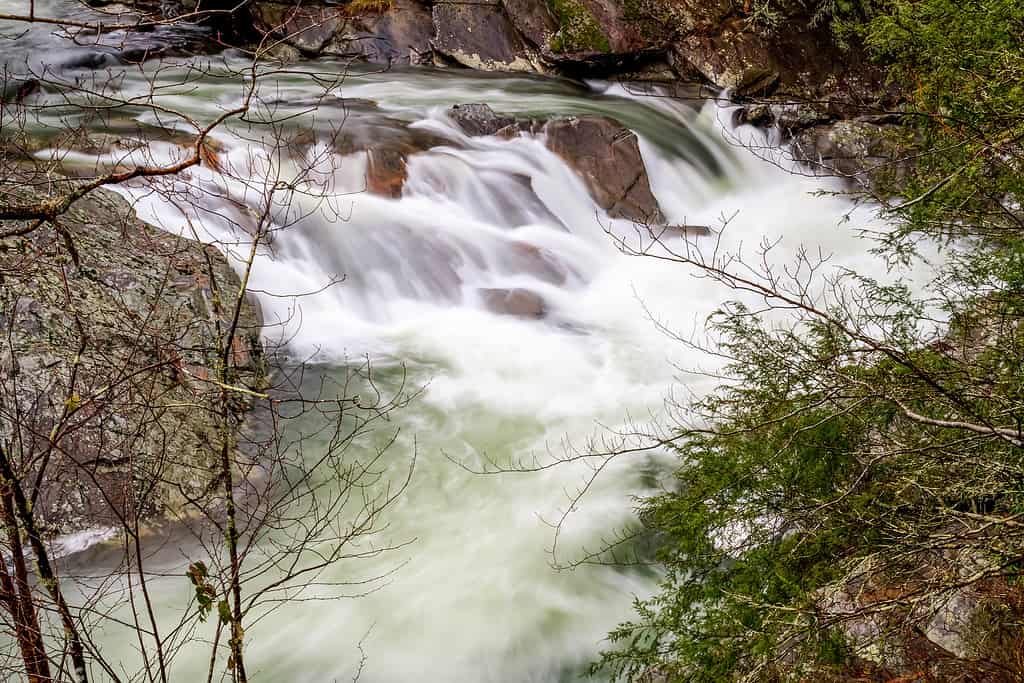
Hiking, camping, fishing, rafting, and kayaking are just some of the activities that can be enjoyed in this majestic area.
©Kenneth Keifer/Shutterstock.com
Salmon River Wildlife
Big Game Species
1. Elk
The Salmon River Basin harbors a diverse range of large game creatures, notably elk, which rely on similar food and shelter requirements as mule deer. However, their habitat remains vulnerable to numerous disruptions, including road construction, logging activities, hydroelectric power plants, and wildfires.
These disturbances also create favorable conditions for the proliferation of invasive plant species, such as cheatgrass. The pursuit of hunting elk has gained significant popularity among visitors to the Salmon River region, especially during the autumn rifle rut season.
2. Bighorn Sheep
The area of the Salmon River and its adjacent streams are prime locations for the roaming of bighorn sheep. It’s common to see them either settling on the top of the canyon’s walls or devouring the vegetation adjacent to the river. Nevertheless, bighorns are experiencing a decreased population due to illnesses spread by domestic sheep and goats.
3. Mule Deer
The Salmon River Basin is renowned for its thriving mule deer population. The deer’s migratory patterns, dictated by ever-changing weather conditions, see them transitioning between their summer and winter dwellings. Mule deer serve as a vital food source for formidable predators like cougars, wolves, and bears and offer abundant delight to hunting enthusiasts and wildlife admirers.
However, human activities in the region, such as road construction and logging, are exacting a toll on the mule deer population in the Salmon River Basin. These activities pose significant threats, including the fragmentation of habitats and disruption and hindrance to the deer’s movement across the landscape.
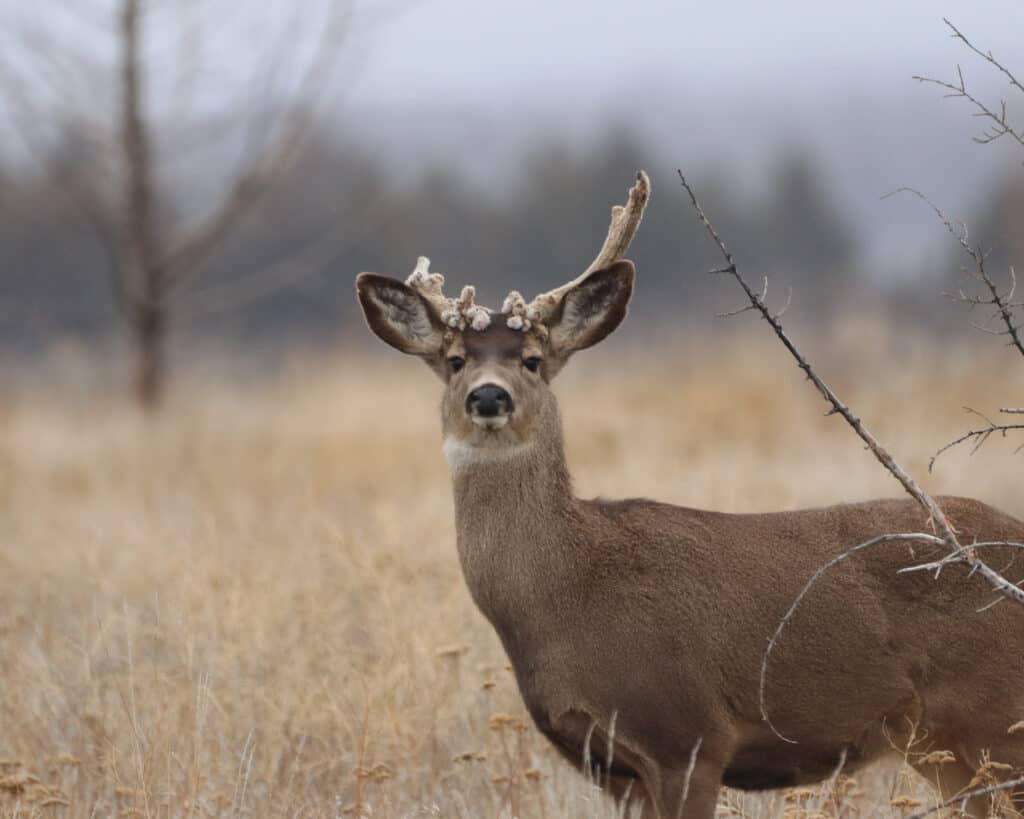
Mule deer, also known as
Odocoileus hemionus, are native to western North America. They are identifiable by their large ears and long legs.
©iStock.com/Mickilu
4. White-Tailed Deer
In stark contrast to elk or mule deer, the white-tailed deer is a nonnative species originating from the East Coast, specifically Pennsylvania. In the 1950s, Idaho Fish & Game introduced this species alongside turkeys to expand hunting opportunities for Idaho residents. The outcome of their endeavors, far from being fruitless, has resulted in a staggering estimated population of over 520,000 white-tailed deer now thriving in Idaho. White-tailed deer are not invasive. Their presence has left the elk, moose, and mule deer populations completely unfazed.
Unlike elk and mule deer, white-tailed deer exhibit a tiny stature. Their physical attributes include comparably shorter legs, smaller heads, and smaller stomachs. Such modest proportions prompt them to seek refuge in densely vegetated areas, enveloped by impenetrable thickets and verdant groves, where they can readily graze on grass. These animals don’t prefer the arid expanse that blankets the southern half of Idaho.
The harsh winters present a formidable obstacle to their survival in the mountainous expanse of central Idaho, where thick brush provides ample cover for white-tailed deer. The meager growth of grass and deep snow make it virtually impossible for the deer to navigate these treacherous conditions. Consequently, the white-tailed deer have adapted by eschewing their mountainous habitat and opting for the more hospitable lower-elevation valleys, particularly those along rivers such as the Salmon.
5. Mountain Goats
Within Idaho’s Salmon River dwells an often overlooked game: the Rocky Mountain Goat. Mountain goats, although not true goats, share a close kinship. These herbivores inhabit alpine environments across North America. Often found in dizzying altitudes, spanning from Alaska to the Rocky Mountains in the United States, they astound with their climbing prowess, surpassing most other animals and even many humans.
With their cloven hooves featuring two wide-spreading toes, their balance is enhanced. The rough pads on each toe function like a natural climbing shoe, ensuring a firm grip. Mountain goats possess strength and agility, capable of leaping nearly 12 feet in a single bound. Distinctive beards adorn these creatures, accompanied by long, insulating coats that shield them from frigid temperatures and the biting mountain winds.
Their striking white coats serve as effective camouflage in the snowy realms. Mountain goats shed their protective outer layer when the more temperate summer season arrives. The domain of mountain goats extends across the northern reaches of Idaho, gracing the rugged landscapes of the White Cloud Mountains in the heart of the state and even venturing as far as the remote southeastern corner.
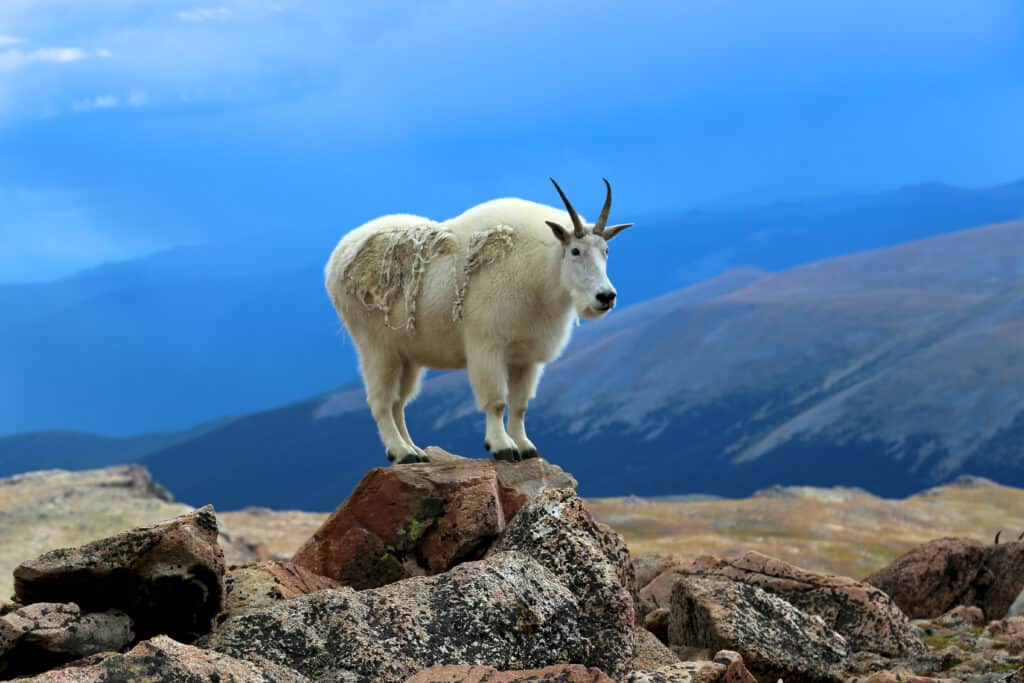
These agile creatures can climb to dizzying heights with ease and have adapted to some of the harshest environments on Earth.
©Steve Boice/Shutterstock.com
6. Black Bear
Black bears exhibit a strong inclination towards mixed deciduous-coniferous forests. However, their habitat selection doesn’t end there; they venture into wet meadows, riparian areas, and even subalpine ridgetops.
Unlike their larger counterparts, grizzlies and coastal brown bears, black bears aren’t commonly associated with the art of salmon fishing. Nonetheless, this doesn’t undermine their prowess near the Salmon River.
In the summertime and autumn months, these resourceful creatures seize every opportunity to catch and devour a substantial quantity of Salmon, diligently stockpiling nourishment for their impending hibernation.
7. Cougar
The majestic mountain lion has long been revered by Native Americans, who saw them as skilled hunters and symbols of both danger and companionship. In the Salmon River area, these elusive creatures, often referred to as pumas, panthers, or cougars, remain scarce, rarely seen by humans. Mountain lions primarily inhabit regions abundant in deer and with sufficient natural shelter.
Small Mammal Species
1. Bobcat
Remarkably challenging to spot, bobcats are known to confound even the most determined observers. When one is fortunate enough to catch a glimpse, these shy creatures blend seamlessly into their surroundings — whether nestled among rocky landscapes, concealed amidst fallen logs within conifer forests, or near meandering rivers, including the Salmon River.
Bobcats, as true carnivores, adhere exclusively to a diet of meat. Their voracious appetite leads them to pursue diverse prey, including birds, aquatic animals, small rodents, and occasionally even sizable deer.
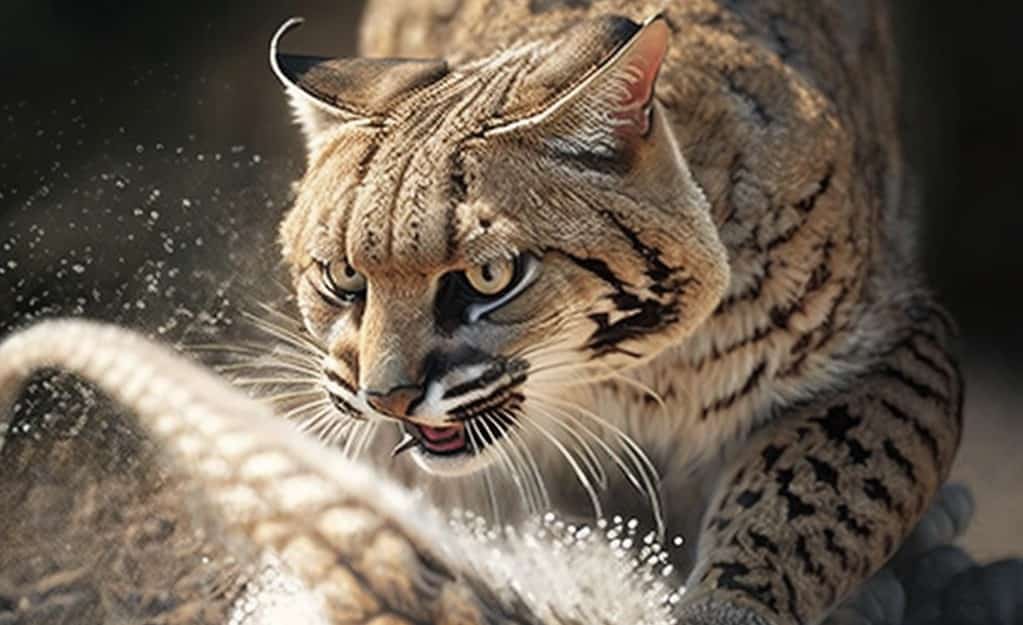
2. Coyote
With a spread-out population at their disposal, coyotes exhibit impressive adaptability when it comes to food. Their dietary preferences lean towards carnivorous inclinations, with 90% of their sustenance deriving from meat. Heavy reliance on animal protein drives these creatures to engage in hunting expeditions, often concentrating their efforts near rivers and lakes.
In addition to feasting on small mammals, such as squirrels and rabbits, coyotes demonstrate their diverse palate by devouring insects, fruit, poultry, livestock, songbirds, deer (particularly fawns and those unfortunate victims of road accidents), and occasionally even game birds.
3. Red Fox
Red foxes frequently inhabit aquatic habitats, drawn to these areas for their ample sheltered spaces conducive to den building and convenient access to water sources from streams and rivers. Their territorial ranges commonly encompass a blend of wooded or forested regions and open grasslands, providing them with a broad array of options for hunting and scavenging. This unique combination of habitats enhances their overall adaptability and biodiversity.
Its menu includes rabbits, small rodents, woodchucks, squirrels, birds, reptiles, amphibians, and eggs. It also indulges in fruits, vegetation, insects, carrion, nuts, and even leftovers.
4. Porcupine
Porcupines are plant-eating rodents. These creatures have stout legs, while their tails range from short to long, with certain variations allowing for grasping capabilities. However, the most intriguing aspect lies within their quills, or spines, which adopt many shapes depending on the particular species. These quills are specialized hairs intricately embedded within the porcupine’s skin and muscular stature.
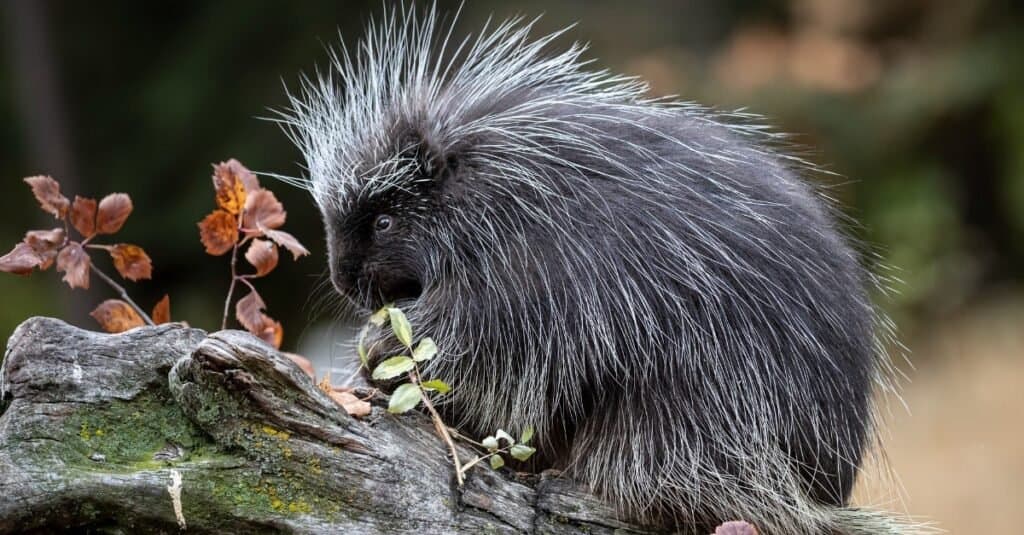
Porcupines are one of the most iconic animals in North America. They have a coat of sharp spines, or quills, that protect them from predators.
©iStock.com/Carol Gray
5. Badger
The Salmon River is home to the badger; this species demonstrates an extraordinary ability to adapt seamlessly to ever-changing landscapes, from vast and sparsely populated fields to expansive prairies and even frigid deserts. It effortlessly traverses through various climates, achieving notable success in the northern regions of Idaho. As omnivores, badgers maintain a flexible diet, including, but not limited to:
- Small mammals
- Insects
- Eggs
- Reptiles
- Various plant materials like grasses, roots, and fruits
Furthermore, they exhibit a distinct affinity for deer carcasses and worms.
6. Beaver
The beaver ranks among the world’s largest rodents. Armed with powerful jaws and robust teeth, they embark on a mission to topple trees, crafting homes and dams that transform their surroundings in unparalleled ways. Water is an essential requirement for the survival of beavers. These creatures establish their habitats near freshwater ponds, marshes, rivers, swamps, and lakes.
Under the cloak of darkness, beavers engage in a bustling nocturnal lifestyle. Their days are consumed by eating activities and the tireless pursuit of construction projects. Diligently, they reinforce their architectural marvels with a waterproof mud seal, ensuring their resilience against the elements. Astonishingly, these dams can stretch for several meters and reach heights of up to 6.5 feet (2 m). Beavers also carve out canals, connecting their havens to expansive water bodies, thus securing a convenient passage for themselves.
7. American Marten
The American marten (Martes americana) belongs to the weasel family and is a carnivorous mammal with a glossy fur coat. While minks and martens may share similarities in color, size, and shape, it is the remarkable behavior of martens to inhabit upland areas predominantly. In contrast, minks are more commonly found near rivers and coastal regions.
Although self-sustaining populations exist near the Salmon River, Island Park, and the Big Hole Mountains, encountering them is rare unless one happens to have a den established near their cabin in the woods, where they can find an easy meal.
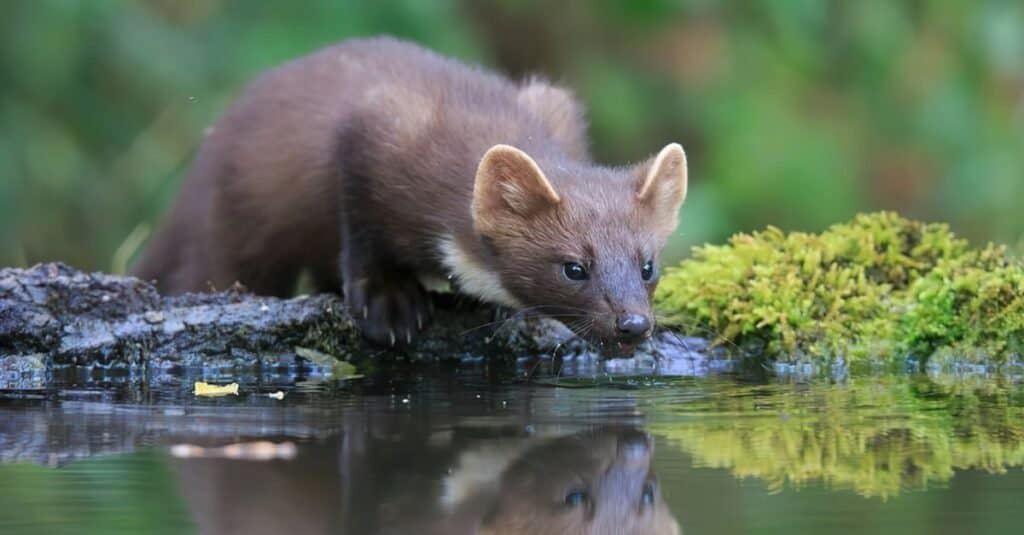
The American marten has thick fur that varies in color from yellowish-brown to dark brown, and it feeds mainly on small mammals, insects, fruits, berries, and nuts.
©Beata Farkas/Shutterstock.com
8. River Otter
River otters are occasionally confused with their significantly larger marine relative, the sea otter. Nevertheless, sea otters have adapted to the saline environment and only venture ashore intermittently for rest and birthing. In contrast, river otters exhibit versatility, thriving in freshwater and brackish habitats and even tolerating saltwater. Moreover, these agile creatures can traverse extensive stretches of land during their travels.
In the vast expanse of the Salmon River, river otters make sporadic appearances that defy our ability to anticipate them. One must possess impeccable timing to catch a glimpse of these elusive creatures, for their presence is a fleeting moment.
At times, a solitary male may grace us with a passing glance, vanishing as swiftly as he arrived. On other occasions, the female otter emerges from the depths during the appropriate season, leading a brood of young ones in tow. The size of her litter can range anywhere from a solitary pup to a trio of energetic juveniles.
9. Muskrat
Muskrats earn their name due to their resemblance to stocky rats. You can encounter these creatures in many serene or sluggish aquatic pathways, including beaver ponds, marshlands, reservoirs, ditches, irrigation canals, and the marshy perimeters of lakes and rivers. They shun the lofty peaks of mountainous regions, for frigid conditions render their food inaccessible.
Muskrats remain active throughout the year, manifesting their presence at any given moment yet displaying heightened vitality during the nocturnal hours. During the daytime, one may spot them foraging or luxuriating under the modest rays of the sun when temperatures plummet.
Seldom do muskrats venture far from the aqueous realm, favoring the art of swimming. Their narrow, pointed tails gracefully meander in the water behind them or extend upwards, forming a poised arch above the surface.
Birds of the Salmon River
- Waterfowl
- Shorebirds
- Songbirds
- Chukar
- Partridge
- Blue grouse, ruffed grouse, and spruce grouse
- Bald eagles
- Osprey
- Red-tailed hawks
Fish Species of the Salmon River
- Bull trout
- Cutthroat trout
- Rainbow trout
- Sturgeon
- Squawfish
- Mountain whitefish
- Steelhead
- Chinook salmon
- Sucker
- Sockeye salmon
- Smallmouth bass
Some of the activities you can do in Salmon River are:
- River rafting and tubing
- Fishing charters and tours
- Hiking and camping
- Sightseeing and history
- Kayaking and canoeing
- Adrenaline and extreme tours
- Nature and wildlife tours
- Private tours
- Multi-day tours
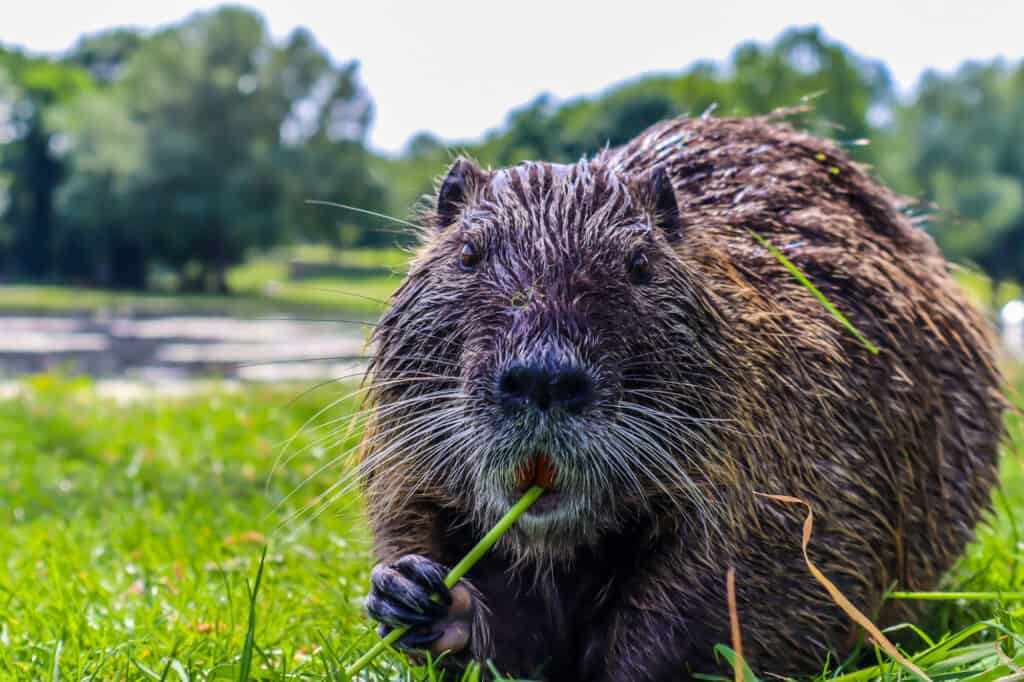
These semi-aquatic rodents feed on aquatic plants, roots, fruits, and insects. Muskrats are excellent swimmers and have scaly tails that aid in swimming and steering.
©iStock.com/w1d
Summing Up the Splendors of Salmon River
The Salmon River, a vital lifeline for ecosystems spanning various parts of the United States, particularly Idaho, holds immense significance that surpasses mere sustenance. It intertwines with industries, facilitates hydroelectric power generation, and serves as a hub for recreational activities within the state. Carving a path across a rugged and scarcely populated watershed, the Salmon River stretches for 425 miles, beckoning adventurous souls with unparalleled opportunities.
Above all, the Salmon River is a testament to nature’s resilience and adaptability. Despite the challenges posed by human activities and environmental disruptions, the river and its inhabitants continue to inspire awe and admiration.
The photo featured at the top of this post is © Simply Photos/Shutterstock.com
Thank you for reading! Have some feedback for us? Contact the AZ Animals editorial team.






